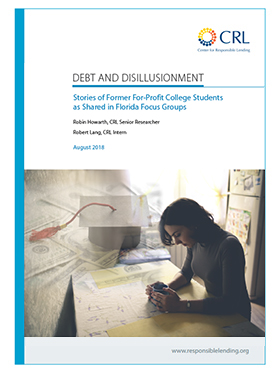Florida is fertile ground for studying for-profit education, given the industry’s outsized presence there and a weak state regulatory environment. In the early summer of 2017, The Center for Responsible Lending (CRL) conducted focus groups in Orlando, Florida with 75 individuals who had attended for-profit colleges within the last 10 years and borrowed to finance their education. The research sought to better understand the circumstances these individuals faced that led them to enroll in their respective schools and their experiences with choosing, enrolling, and attending the school; finding a job after leaving the program; and taking out and repaying their loans.
We also asked students to reflect on the ways in which for-profit college attendance had colored their notions about the value of higher education, the ability of low-income students to achieve financial stability, and the intergenerational impact of student debt. This paper describes the goals of this project and the circumstances particular to Florida that make it a good place to look at this problem. We also provide descriptive information about the participants and share high-level findings from both the moderated conversations and two supplemental survey instruments measuring financial activity and well-being.
Key Findings Include
- The focus group participants came from difficult circumstances that influenced the way they thought about higher education options. Despite the necessity to borrow large amounts of money to attend Florida for-profit colleges, schools drew participants to enroll through intense advertising and personal recruiting; quick, frictionless enrollment; flexible scheduling; and the lack of entrance requirements.
- The participants often found the educational experience at for-profit colleges to be superficial and frustrating. A number of participants dropped out when they: determined that the amount of debt and time they were investing was “not worth it,” ran out of financial aid, experienced a life emergency, or discovered that promises of gainful employment upon graduation were unlikely to materialize.
- Irrespective of completion status, student debt levels were very high after leaving school, with a median of $22,000 overall and even higher median figures for female, middle-aged, and African-American borrowers.
- Very few participants (including those who left school many years previously) were able to make any progress in repaying their debts. Even participants that had jobs before, during, and after attending school reported that their earnings did not appear to change significantly in a way that allowed them to repay their loan. Serial deferment and forbearance were common, and a number of participants referenced default, wage garnishment, and tax offsets. Many students’ debts had grown beyond original amounts borrowed due to large amounts of added interest and fees.
- The impact of heavy student debt burdens was both psychological and material. Participants had not been able to pursue goals such as homeownership, saving for children’s education, and preparing for their own retirement. Extreme stress and anxiety over debt repayment was common. Participants reflected that for-profit colleges could be a trap for students and that their own poor educational and employment outcomes as a result of attending for-profits must not be repeated by their children.
- Results from the two short surveys administered after the focus group session confirmed the above findings. The Consumer Financial Protection Bureau (CFPB) Financial Well-Being Scale revealed that participants scored no better than the average high-school graduate. CRL’s Financial Products Survey showed that participants’ use of harmful financial products (payday, overdraft, etc.) or negative financial events (contacted by a debt collector, considered bankruptcy) increased after taking out student debt.
